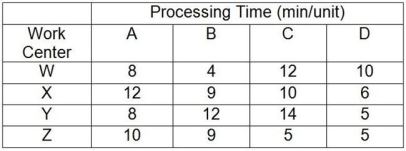Table 5.2
A company makes four products that have the following characteristics: Product A sells for $75 but needs $20 of materials and $20 of labor to produce; Product B sells for $90 but needs $45 of materials and $20 of labor to produce; Product C sells for $110 but needs $50 of materials and $30 of labor to produce; Product D sells for $135 but needs $75 of materials and $40 of labor to produce. The processing requirements for each product on each of the four machines are shown in the table.

Work centers W, X, Y, and Z are available for 40 hours per week and have no setup time when switching between products. Market demand is 50 As, 60 Bs, 70 Cs, and 80 Ds per week. In the questions that follow, the traditional method refers to maximizing the contribution margin per unit for each product, and the bottleneck method refers to maximizing the contribution margin per minute at the bottleneck for each product.
-Use the information in Table 5.2. Using the bottleneck method, what is the profit if the company manufactures the optimal product mix (consider variable costs only-overhead is not included in this profit calculation) ?
Definitions:
Appraised Value
The estimated monetary value of an asset determined by a professional appraiser based on its features and market conditions.
Land Account
An account on the balance sheet representing the cost of land owned by a company that is used in its operations.
Appreciated
Increased in value or worth over time, often used in the context of assets like property or investments.
Capitalized Cost
The total cost of a purchased asset, including acquisition price and all costs to bring the asset to a functioning state.
Q32: Use the information in Table 5.2. Using
Q56: Variability of a firm's workload may create
Q58: Calculate three forecasts using the following data.
Q64: A linear regression model is developed that
Q88: Which of the following would be considered
Q103: One chart commonly used for quality
Q114: The Delphi method is a process of
Q122: The fifth step in Theory of Constraints
Q132: Customers demand muffalettas at the rate of
Q136: A linear regression model results in the